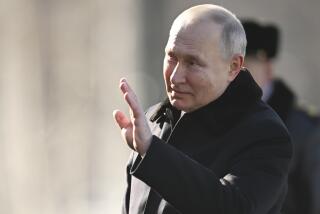Political Impact of Soviet Decision Weighed : Cut in Forces Might Derail NATO Modernization Plan
- Share via
NEW YORK — Mikhail S. Gorbachev’s promised unilateral reduction of the Soviet armed forces carries even more political than military significance, U.S. analysts said Wednesday, although it is by no means trivial in strictly military terms.
Although the North Atlantic Treaty Organization had expected such a move for months, the slashing of half a million troops from the Soviet force of 5.1 million may prove to be an unsettling Christmas present: It will increase the political pressure on NATO to respond in kind and to forgo modernizing its short-range nuclear forces in Western Europe.
The force reductions themselves will not be insignificant, Soviet experts added, but they will not be deep enough to risk a challenge to Moscow’s authority by the national forces of its Eastern European allies.
While Gorbachev repeated nyet four times to deny that he faced any opposition from the Soviet military to the troop cuts, U.S. experts are virtually unanimous in believing that the Kremlin leader engineered the plan only after winning a bitter fight with the military.
That Gorbachev was able to gain Politburo support for the troop withdrawal demonstrates that he remains firmly in control at home. The official reason for the resignation of Marshal Sergei F. Akhromeyev as chief of staff of the Soviet armed forces--concern for his health--drew smiles from U.S. analysts.
The Soviet move was politically significant because of the likelihood that it will bring heavy pressure on the United States to cut its forces, perhaps including some of its 300,000 troops in Europe, to achieve the same kinds of budgetary savings that apparently motivated the Kremlin.
There undoubtedly will be an increase in U.S. demands for greater European support of those American forces--a policy called “burden sharing.”
And, as Secretary of State George P. Shultz said, NATO “will now have to factor (the Gorbachev announcement) into how we position ourselves in the coming conventional force talks” about reducing men and armaments in both East and West.
Key nations within the Atlantic Alliance differ importantly on what to seek in the talks, with the French preferring no force cuts at all and the West Germans seeking mainly reductions in short-range nuclear weapons.
Although President Reagan immediately welcomed the Soviet move, Shultz noted that even after the force reductions take place by 1991, the Soviets will have military superiority in conventional forces. “Very significant asymmetry” will continue to exist, he said, to the Warsaw Pact’s advantage.
Instead of a 2.5-to-1 advantage in tanks, for example, the Soviet margin will be 2 to 1, according to published figures. The Soviets will also still have an almost 3-to-1 edge in artillery pieces.
There was “very little discussion” of the force reductions when Gorbachev met with Reagan and President-elect George Bush immediately after he announced his plan, Shultz said, even though from a substantive as well as public relations standpoint, Gorbachev’s address clearly eclipsed the meeting.
Gorbachev Concessions Seen
Gorbachev’s speech contained several other important statements that were viewed as concessions to U.S. demands in at least two respects:
-- The Soviet Union is prepared to resolve the dispute over the Krasnoyarsk radar station in Siberia “by dismantling and refitting certain units and structures,” he said. Washington has long contended that the radar violates the 1972 Anti-Ballistic Missile Treaty and must be dismantled before any new arms control agreements can be signed.
Shultz said Reagan confirmed with Gorbachev that the Soviet leader had in fact used the key word “dismantle.” At that point, Shultz said, the summit lunch moved to other subjects, as if the very difficult issue had finally been resolved, at least in principle.
-- The Soviet Union will provide “guarantees” in new laws that rule out any persecution on political or religious grounds, Gorbachev said, and it will take other action that “removes from the agenda the problem of so-called refuseniks.”
His assurance goes far toward meeting Western conditions for beginning new negotiations on reducing conventional forces in Europe, Shultz indicated in briefing reporters.
But it was Gorbachev’s arms reduction announcement that stole the day, even though U.S. officials had predicted unilateral Soviet manpower cuts as long ago as September, and even though the Soviet leader provided few key details, such as whether the half-million men to be cut will come from the best or worst units.
“The 500,000 men are less significant to me than the six divisions and (5,000) associated tanks,” said Arnold Horelick, director of the RAND Corp./UCLA Center for Soviet Studies. Six divisions, he said, represent one-fifth of the 30 first-line Soviet tank and infantry divisions in Eastern Europe that pose the greatest offensive threat to the NATO bloc.
And if, as Gorbachev promised, “the Soviets also restructure their remaining forces to be less offensively poised,” said Jack Mendelsohn, deputy director of the private Arms Control Assn., “it will create a whole new atmosphere in Central Europe.”
Gorbachev, broadly acknowledging that economics had motivated the cuts, offered to share with other countries the Soviet experience of converting defense plants to the production of civilian goods.
“He decided to do it unilaterally,” said Stanford Prof. Condoleezza Rice, “to spur the conventional arms talks and make NATO come back with a significant offer next year. I think he feared that otherwise, those talks would drag out until he would get no economic benefit from whatever reductions were eventually agreed on.”
Harry Gelman, a former CIA analyst now with the RAND Corp., added: “This is fresh evidence of the gravity of his economic situation at home and his need to relieve the external burden on his resources.”
More to Read
Sign up for Essential California
The most important California stories and recommendations in your inbox every morning.
You may occasionally receive promotional content from the Los Angeles Times.









